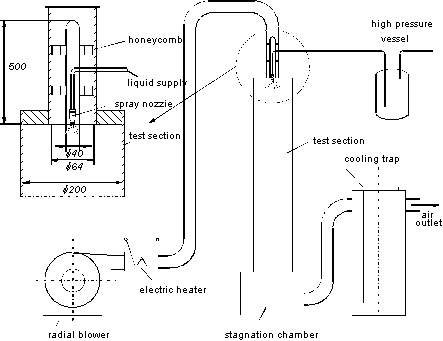Abstr:Spray evaporation in turbulent flow
Application Area 3: Chemical & Process, Thermal Hydraulics & Nuclear Safety
Application Challenge AC3-08
Abstract
In order to provide data for the validation of numerical calculations, the spray evaporation in a heated turbulent air stream was studied experimentally (Sommerfeld and Qiu, 1998). The flow configuration was a pipe expansion with an expansion ratio of three, where heated air entered through an annulus with the hollow cone spray nozzle being mounted in the centre (Fig. 1). In the experiments isopropyl-alcohol was used as a liquid due to its high evaporation rates. Measurements were taken for different flow conditions, such as air flow rate, air temperature, and liquid flow rate in order to provide a set of reliable data. Phase-Doppler anemometry (PDA) was applied to obtain the spatial change of the droplet size spectrum in the flow field and to measure droplet size-velocity correlations. From these local measurements, profiles of droplet mean velocities, velocity fluctuations, and droplet mean diameters were obtained by averaging over all droplet size classes. Moreover, recent extensions of the PDA signal processing (Sommerfeld and Qui, 1995) allowed to determine accurately profiles of the droplet mass flux, whereof also the global evaporation rates could be determined. The data for the different flow conditions also include the inlet conditions for air flow and spray (i.e. for all three velocity components), inlet temperature and wall temperature profiles. The latter was measured using a thermocouple with a special wall sensor.
A number of processes in chemical and food industry (e.g. spray drying) and in combustion science involve the evaporation of atomised liquids in a turbulent environment. The droplet evaporation is strongly governed by turbulent dispersion and gas temperature distribution. Therefore, this application challenge is rather demanding and requires appropriate modelling of the following effects:
- flow field and turbulence structure
- gas temperature distribution
- two-way coupling which strongly changes the temperature field due do droplet evaporation
- turbulent dispersion of droplets
- droplet heating and evaporation
The assessment parameters for this application challenge are the velocity profiles of both phases along the test section, including mean velocities for the axial and radial component, as well as the associated rms-values. Additionally, profiles of droplet mean diameters and droplet mass flux can be used. From the liquid mass flow along the test section also the global evaporation rate may be used as an assessment parameter.
Contributors: Martin Sommerfeld - Martin-Luther-Universitat Halle-Wittenberg

